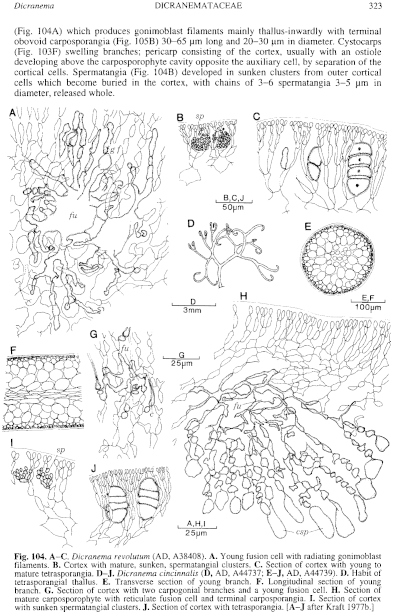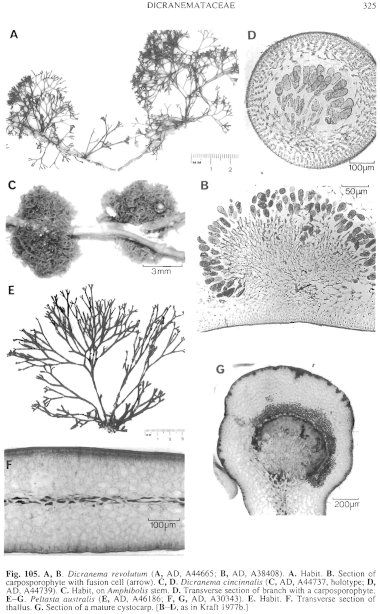|
|
|
|
|
|||||||||||
|
Electronic Flora of South Australia Species Fact Sheet
Phylum Rhodophyta – Class Florideophyceae – Order Gigartinales – Family Dicranemataceae
Selected citations: Harvey 1859a: pl. 74. Kraft 1977b: 223, figs 1–3, 12, 14 (caption for 13). Kylin 1932: 66.
Synonyms
Sphaerococcus revolutus C. Agardh 1822: 334.
Dicranema grevillei Sonder 1845: 56; 1848: 173. J. Agardh 1852: 634; 1876: 435; 1879: pl. 26 figs 4, 5. Harvey 1855a: 549; 1859a: pl. 120. Kylin 1932: 66.
Thallus (Fig. 105A) red-brown, fading to yellow-brown, cartilaginous, 2–5 (–7) cm high, with rigid, terete, subdichotomous branches 400–600 µm in diameter, apices rounded, branched at intervals of mostly 2–10 mm. Holdfast crustose, extending around the host stems, with one to a few fronds; epiphytic on Amphibolis. Structure multiaxial (Fig. 103H) with a narrow medullary core (Fig. 103I) of slender elongate cells and a broad pseudoparenchymatous cortex of inner ovoid cells 20–40 µm in diameter and a small-celled outer cortex 2–3 cells thick, outer cells 2–3 µm in diameter. Rhodoplasts discoid to ribbon shaped, few per cell.
Reproduction: Sexual thalli monoecious; non-procarpic. Carpogonial branches (Fig. 103J) 2-celled with long straight trichogynes, situated to one side of the branch apices. Auxiliary cells adjacent to carpogonia and fusing with them, then developing a fusion cell (Fig. 104A) which produces gonimoblast filaments mainly thallus-inwardly with terminal obovoid carposporangia (Fig. 105B) 30–65 µm long and 20–30 µm in diameter. Cystocarps (Fig. 103F) swelling branches; pericarp consisting of the cortex, usually with an ostiole developing above the carposporophyte cavity opposite the auxiliary cell, by separation of the cortical cells. Spermatangia (Fig. 104B) developed in sunken clusters from outer cortical cells which become buried in the cortex, with chains of 3–6 spermatangia 3–5 µm in diameter, released whole.
Tetrasporangial nemathecia (Fig. 103G) surrounding the apical 1–2 mm of branches, tetrasporangia (Fig. 104C) basally attached to mid cortical cells, ovoid, 60–90 µm long and 25–35 µm in diameter, zonately divided.
Type from Bay de Chien Marin (Shark Bay), W. Aust.; holotype in Herb. Agardh, LD, 29977.
Selected specimens: (see also Kraft 1977b, p. 223): Port Denison, W. Aust., drift (Kraft, 14.xii.1971; AD, A44733). Cape Riche, W. Aust. (Harvey, Alg. Aust. Exsicc. 314C; AD, A8295). Petrel Bay, St Francis I., Isles of St Francis, S. Aust., 2 m deep (Shepherd, 10.i.1971; AD, A38408). Tiparra Reef, S. Aust., 6 m deep (Owen, 2.iv.1971; AD, A44734). Vivonne Bay, Kangaroo I., S. Aust., drift (Womersley, 2.i.1949; AD, A10704). Port Elliot, S. Aust., 3 m deep (Kraft, 15.viii.1973; AD, A44736). Robe, S. Aust., upper sublittoral near jetty (Womersley, 16.ii.1974; AD, A44665 -"Marine Algae of southern Australia" No. 159). Double Corner Beach, Portland, Vic., drift (Beauglehole, 22.vi.1952; AD, A21758). Point Lonsdale, Vic., 4–5 m deep (Kraft, 14.ii.1977; MELU, A39566). Point Franklin, Port Phillip Bay, Vic., 10 m deep (Macpherson, 3.iv.1963; AD, A28687). Walkerville, Vic., drift (Sinkora A2100, 27.ii.1975; AD, A48399).
Distribution: Shark Bay, W. Aust., to Walkerville, Vic., and Flinders I., Bass Str.; an obligate epiphyte on Amphibolis.
Taxonomic notes: D. revolutum was previously better known as D. grevillei until Kraft (1977b, p. 221) showed that the latter was the same as the type of the former, and the plant often known as D. revolutum was distinct, renamed as D. cincinnalis. Records of D. revolutum from elsewhere [e.g. Trono & Ganzon-Fortes (1988, p. 152)] are incorrect.
References:
AGARDH, C.A. (1822). Species Algarum. Vol. 1, Part 2, pp. 169–398. (Berling: Lund.)
AGARDH, J.G. (1852). Species Genera et Ordines Algarum. Vol. 2, Part 2, pp. 337–720. (Gleerup: Lund.)
AGARDH, J.G. (1876). Species Genera et Ordines Algarum. Vol. 3, Part 1 - Epicrisis systematis Floridearum, pp. i-vii, 1–724. (Weigel: Leipzig.)
AGARDH, J.G. (1879). Florideernes morphologi. K. Svenska Vetensk. Akad. Handl. 15(6), 1–199, Plates 1–33.
HARVEY, W.H. (1855a). Some account of the marine botany of the colony of Western Australia. Trans. R. Ir. Acad. 22, 525–566.
HARVEY, W.H. (1859a). Phycologia Australica. Vol. 2, Plates 61–120. (Reeve: London.)
KRAFT, G.T. (1977b). Studies of marine algae in the lesser-known families of the Gigartinales (Rhodophyta). H. The Dicranemaceae. Aust. J. Bot. 25, 219–267.
KYLIN, H. (1932). Die Florideenordnung Gigartinales. Lunds Univ. Årsskr. N.F. Avd. 2, 28 (8), 1–88, Plates 1–28.
SONDER, O.G. (1845). Nova Algarum genera et species, quas in itinere ad oras occidentales Novae Hollandiae, collegit L. Preiss, Ph.Dr. Bot. Zeit. 3, 49–57.
SONDER, O.W. (1848). Algae. In Lehmann, C., Plantae Preissianae. Vol. 2, pp. 161–195. (Hamburg.)
TRONO, G.C. & GANZON-FORTES, E.T. (1988). Philippine Seaweeds. (National Book Store Inc.: Quezon City.)
The Marine Benthic Flora of Southern Australia Part IIIA complete list of references.
Publication:
Womersley, H.B.S. (14 January, 1994)
The Marine Benthic Flora of Southern Australia
Rhodophyta. Part IIIA, Bangiophyceae and Florideophyceae (to Gigartinales)
Reproduced with permission from The Marine Benthic Flora of Southern Australia Part IIIA 1994, by H.B.S. Womersley. Australian Biological Resources Study, Canberra. Copyright Commonwealth of Australia.
Illustrations in Womersley Part IIIA, 1994: FIGS 103 F–J, 104 A–C, 105A, B.

Figure 103 enlarge
Fig. 103. A. Sarcodia marginata (AD, A24453). Transverse section of cortex with tetrasporangia. B–D. Trematocarpus concinnus (AD, A61617). B. Cortical filaments with a 3-celled carpogonial branch. C. Cortical filaments with spermatangial chains. D. Cortical filaments with tetrasporangia. E. Trematocarpus affinis (AD, A31949). Cortical filaments with tetrasporangia. F–J. Dicranema revolutum (AD, A38408). F. Branch ends with cystocarps. G. Terminal branches with tetrasporangial nemathecia. H. Longitudinal section of branch apex. I. Transverse section of branch with medullary core and large inner cortical cells. J. Cortex with deep-seated carpogonial branches. [F–J after Kraft 1977b.]

Figure 104 enlarge
Fig. 104. A–C. Dicranema revolutum (AD, A38408). A. Young fusion cell with radiating gonimoblast filaments. B. Cortex with mature, sunken, spermatangial clusters. C. Section of cortex with young to mature tetrasporangia. D–J. Dicranema cincinnalis (D, AD, A44737; E–J, AD, A44739). D. Habit of tetrasporangial thallus. E. Transverse section of young branch. F. Longitudinal section of young branch. G. Section of cortex with two carpogonial branches and a young fusion cell. H. Section of mature carposporophyte with reticulate fusion cell and terminal carposporangia. I. Section of cortex with sunken spermatangial clusters. J. Section of cortex with tetrasporangia. [A–J after Kraft I 977b.]

Figure 105 enlarge
Fig. 105. A, B. Dicranema revolutum (A, AD, A44665; B, AD, A38408). A. Habit. B. Section of carposporophyte with fusion cell (arrow). C, D. Dicranema cincinnalis (C, AD, A44737, holotype; D, AD, A44739). C. Habit, on Amphibolis stem. D. Transverse section of branch with a carposporophyte. E–G. Peltasta australis (E, AD, A46186; F, G, AD, A30343). E. Habit. F. Transverse section of thallus. G. Section of a mature cystocarp. [B–D, as in Kraft 1977b.]

|
Email Contact: State Herbarium of South Australia |

|